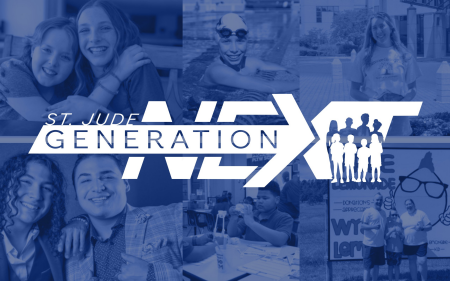
Childhood cancer survivor now boosts researchers' search for a cure
Treated for cancer in his teens, Chase Carter now helps raise funds and awareness for St. Jude Children's Research Hospital.

August 12, 2020 • 4 min

As a teenager growing up in rural Alaska, Chase Carter was given a label, a misnomer of sorts — “the kid with cancer.”
“When I became an adult and left (for college), I stopped talking about it,” he said.
Now, he's embracing the title he once wanted to shed. As a regional market director for ALSAC, the fundraising and awareness organization for St. Jude Children’s Research Hospital, it is Chase’s job to talk about pediatric cancer.
He's owning his narrative as “the kid with cancer,” in hopes that one day cancer will be a thing of the past.
“Part of me doesn’t like talking about it, but part of me knows it brings hope to other people,” Chase said. “If it helps, I want to be a part of it.”
Cancer is a bully
It was the beginning of junior high school and Chase began to develop a lot of bruises.
“My mom was convinced I was being bullied,” he said.
Chase couldn’t explain the bruises, but he knew they weren’t from his classmates. His condition worsened with fever, and his mom took him to the doctor.
“The doctor came in and said, ‘There’s something wrong with you — seriously wrong with you. It could be leukemia,’” Chase recalled. “I spent one night in my hometown and flew out the next day.”
Chase, then 12, was transported to a children’s hospital several states away where he was diagnosed with acute lymphoblastic leukemia.
For a year, he received treatment with the few other teenagers who had cancer, before returning to Alaska to receive another four years of treatment through his family doctor. Chase was the only survivor.
“It teaches you the value of life and to not sweat the small things,” he said. “I don’t wish the experience on anyone, but it definitely gives you perspective.”
Chase was able to beat leukemia with a treatment protocol developed at St. Jude.
“I always knew in the back of my mind that St. Jude helped. I guess it saved my life, but I never really thought about it,” Chase said.
That is until he started working for ALSAC and toured St. Jude, where research conducted by scientists and doctors is shared freely around the world to save as many children as possible.
“There’s this t-shirt we have at the gift shop — ‘One child saved at St. Jude is 1,000 children around the world.’ That’s me,” Chase said. “There are thousands of kids alive today, who aren’t St. Jude patients, who benefited from the research conducted there that was shared.”
A lifelong patient
Although Chase finished treatment years ago, he still contributes to the research taking place at St. Jude today. Ever since being treated for cancer as a teen, he has periodically sent health data and even samples of his DNA to a lab at St. Jude.
For years, the census-like packet he received in the mail was his only connection to the hospital.
As ALSAC’s market director for the Nevada and Utah region, Chase had a work trip to St. Jude last August.
He was curious about how he was contributing to the future of pediatric cancer treatment. As an employee, he didn’t want to overstep his bounds. As a study participant, he had questions.
He finally convinced himself it would be OK to at least send an email.
Within the hour, the study’s principal investigator, Dr. Gregory Armstrong, responded with open arms, inviting Chase to stop by, meet the study team and put a face to the data they work with each day.
It also happened to be Chase’s birthday.
“It was a great way to turn 34,” he said.
Seeing true humanity
When Chase met the study team, they only knew him on paper. They were familiar with his diagnosis and treatment. They had compiled years of data and samples, but hearing his story firsthand gave the work they do renewed meaning.
“From our perspective, it felt like we were family in the sense that we are all trying to do the same thing — all trying to find cures and save lives,” said Dayton Rinehart, who coordinates survey interviewers at St. Jude.
As a participant in the Long-Term Follow-Up Study, Chase is helping create the field of cancer survivorship.
“About 20 to 30 years ago, no one really knew what it meant to be a survivor,” Dayton said. “Thanks to our participants, we have been able to describe the phenomenon of being a survivor and help educate both survivors and clinicians about possible late effects.”
Late effects, Dayton explained, are health problems that persist or develop later in life and are associated with the treatments survivors received for their childhood cancer.
“The goal is to help survivors live the best life possible,” Dayton said. “Information from the study has also helped inform the current treatment protocols to try to reduce or eliminate future late effects.”
To date, Chase has not been treated for a long-term side effect.
“My primary care physician usually gives me a full, clean bill of health,” he said, “so, that’s encouraging.”
With more than 30,000 study participants from more than 31 treatment centers across the U.S. and Canada, much has been done, and continues to be done, to mitigate and overcome the effects of lifesaving treatments, Dayton said.
“If you are paying attention to the news, it seems like we’re inching closer to catastrophe — fires in Australia, COVID-19 and a country divided. That’s not reality,” Chase said. “The real world is people seeing other people in need and helping them. We are putting aside our differences because we are saving kids’ lives and that’s what’s important. I get to see true humanity in this job, and I am eternally grateful.”






